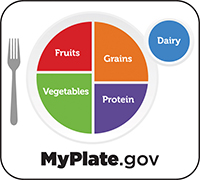Understanding USDA MyPlate
The USDA has guidelines to help you make healthy food choices. These are called MyPlate. MyPlate shows the food groups that make up healthy meals using the image of a place setting. Before you eat, think about the healthiest choices for what to put on your plate or in your cup or bowl. To learn more about building a healthy plate, visit www.myplate.gov.

The food groups
-
Fruits. Any fruit or 100% fruit juice counts as part of the Fruit Group. Fruits may be fresh, canned, frozen, or dried, and may be whole, cut-up, or pureed. Make 1/2 of your plate fruits and vegetables.
-
Vegetables. Any vegetable or 100% vegetable juice counts as a member of the Vegetable Group. Vegetables may be fresh, frozen, canned, or dried. They can be served raw or cooked and may be whole, cut-up, or mashed. Make 1/2 of your plate fruits and vegetables.
-
Grains. All foods made from grains are part of the Grains Group. These include wheat, rice, oats, cornmeal, and barley. Grains are often used to make foods such as bread, pasta, oatmeal, cereal, tortillas, and grits. Grains should be no more than 1/4 of your plate. At least half of your grains should be whole grains.
-
Protein. This group includes meat, poultry, seafood, beans and peas, eggs, processed soy products (such as tofu), nuts (including nut butters), and seeds. Make protein choices no more than 1/4 of your plate. Meat and poultry choices should be lean or low fat.
-
Dairy. The Dairy Group includes all fluid milk products and foods made from milk that contain calcium, such as yogurt and cheese. (Foods that have little calcium, such as cream, butter, and cream cheese, are not part of this group.) Most dairy choices should be low-fat or fat-free.
Things to limit
Eating healthy also means limiting these things in your diet:
-
Oils. Oils aren't a food group, but they do contain essential nutrients. These are fats that are liquid at room temperature. Including small amounts of oils in your diet is fine and can even be good for you. But it's important to watch how much oil you include in your diet. Oils include avocado, canola, corn, olive, soybean, vegetable, and sunflower. Foods that are mainly oil include mayonnaise, certain salad dressings, and soft margarines. You likely already get your daily oil allowance from the foods you eat.
-
Salt (sodium). Many processed foods have a lot of sodium. To keep sodium intake down, eat fresh vegetables, meats, poultry, and seafood when possible. Buy low-sodium, reduced-sodium, or no-salt-added food products at the store. And don't add salt to your meals at home. Instead, season them with herbs and spices such as dill, oregano, cumin, and paprika. Or try adding flavor with vinegar, onion, garlic, or lemon or lime zest and juice.
-
Saturated fat . Saturated fats are most often found in animal products such as beef, pork, and chicken. They are often solid at room temperature, such as butter. To reduce your saturated fat intake, choose leaner cuts of meat and poultry. And try healthier cooking methods such as grilling, broiling, roasting, or baking. For a simple lower-fat swap, use plain nonfat yogurt instead of mayonnaise when making potato salad or macaroni salad.
-
Added sugars. These are sugars added to foods. They are in foods such as ice cream, candy, soda, fruit drinks, sports drinks, energy drinks, cookies, pastries, jams, and syrups. Cut down on added sugars by sharing sweet treats with a family member or friend. You can also choose fruit for dessert, and drink water or other unsweetened beverages.
-
Alcohol. Alcohol contains calories but few nutrients. If you don't drink alcohol, don't start drinking for any reason. But if you do choose to drink alcohol, do so only in moderation. This means no more than 2 drinks in a day for men and no more than 1 drink per day for women, on days when you have alcohol.
© 2000-2024 The StayWell Company, LLC. All rights reserved. This information is not intended as a substitute for professional medical care. Always follow your healthcare professional's instructions.